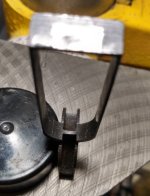Aguila Blanca
Staff
According to the Ordnance Department drawings, the trigger shoe for the M1911A1 was steel, and was attached to the trigger bow by crimping in two locations.
The newer 80 series Colts use an aluminum trigger shoe. First question: Does anyone know what would be an appropriate aluminum alloy for use as a trigger shoe?
Second question: There's no crimp visible from the sides of the trigger shoe. There are two round-ish indentations in the back of the shoe that effectively close up the slot the bow fits into. Does anyone know how that operation is accomplished? Is it just a different crimp, or is it TIG welded inside the slot?
Thanks.
The newer 80 series Colts use an aluminum trigger shoe. First question: Does anyone know what would be an appropriate aluminum alloy for use as a trigger shoe?
Second question: There's no crimp visible from the sides of the trigger shoe. There are two round-ish indentations in the back of the shoe that effectively close up the slot the bow fits into. Does anyone know how that operation is accomplished? Is it just a different crimp, or is it TIG welded inside the slot?
Thanks.

